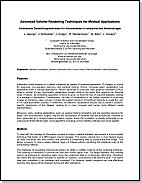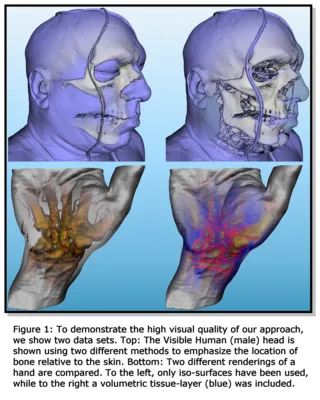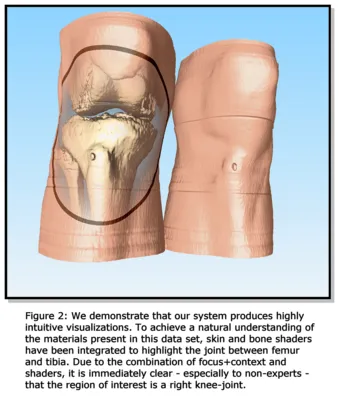Advanced Volume Rendering Techniques for Medical Applications
Joachim Georgii, Jens Schneider, Jens Krüger, Rüdiger Westermann
Computer Graphics and Visualization Group, Technische Universität München, Germany
Maximilian Eder, Laszlo Kovacs
Abteilung für Plastische und Wiederherstellende Chirurgie, Klinikum rechts der Isar, Technische Universität München, Germany
Background
Interactive visual analysis of a patient’s anatomy by means of computer-generated 3D imagery is crucial for diagnosis, pre-operative planning, and surgical training. Hence, computer-aided visualization has established itself in medical applications. Recent advances in consumer class graphics hardware (GPUs) allow a number of new, high-quality visualization modes, while at the same time reducing the financial costs. However, as computing capacities continue to grow, so does the size of acquired datasets, leading to a barrage of information. Consequently, the task of visualization is not limited anymore to producing images at interactive rates, but also includes the guided extraction of significant features to assist the user in the data exploration process. Furthermore, an effective visualization module has to perform problem-specific abstraction of the dataset, leading to a more compact and hence more efficient visual representation.
Moreover, many medical applications, such as surgical training simulators and pre-operative planning for plastic and reconstructive surgery, require the visualization of datasets that are dynamically modified or even generated by a physics-based simulation engine. Since the simulation is usually performed on an unstructured finite element grid, novel algorithms including correct visibility ordering have to be applied.

Associated publications
Advanced Volume Rendering Techniques for Medical Applications
J. Georgii, J. Schneider, J. Krüger, R. Westermann, M. Eder, L. Kovacs,
5. Jahrestagung der Deutschen Gesellschaft für Computer- und Roboterassistierte Chirurgie (CURAC), 2006
[Bibtex][PDF]


